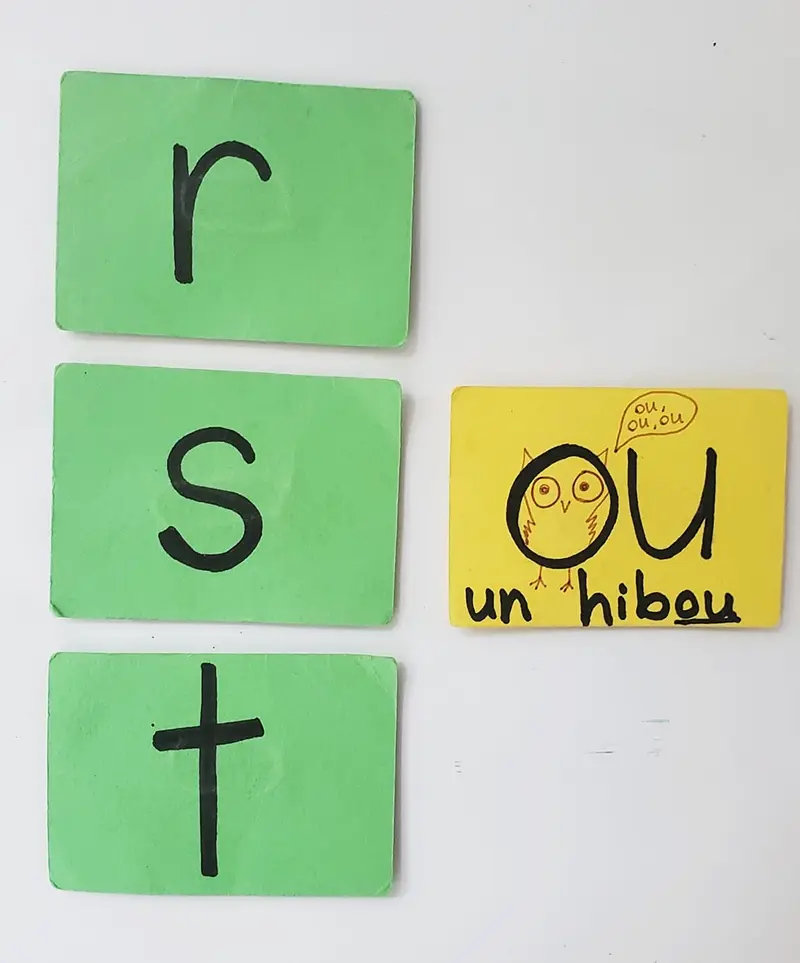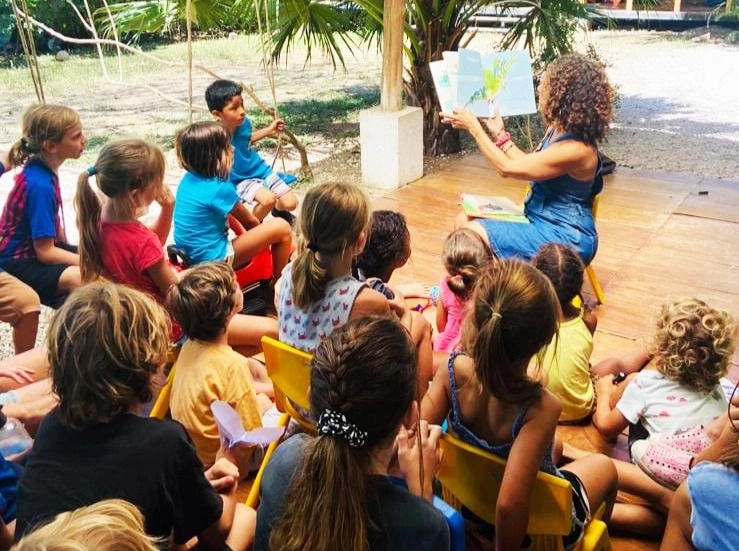The Science of Reading
- Madame Karine

- Mar 14, 2024
- 7 min read
Updated: Oct 10
Why the Science of Reading is Vital in Learning How to Read: An Introduction to My French Reading Video Course
By Madame Karine, French immersion teacher from Calgary, living in Costa Rica

We all have natural abilities in some things while we struggle in others. I know for me; one notion I struggle with is my sense of direction. I love using maps because they are a visual aid but to feel my way back to a place, I have only visited a couple of times or more, is a challenge.
Although I consider myself having strong instincts and intuition when it comes to other feats; I can honestly say that this ability is nowhere to be found when it comes to directions. Finding my way through instinctual memory is a definite challenge. I truly feel like I have a dyslexion in this department. I see it in my kids as well. My daughter has and always had a great sense of direction from a very young age while my poor son, who is the eldest, can easily get lost like me.
Why the science of reading is so important to use when teaching reading
Learning to read is of no exception. For some learners, it feels innate, and they become fluid readers quickly. For others, it is a struggle. A long and challenging road that has nothing natural or instinctive about it.
Many try and remedy this difficulty by teaching a learner to memorize texts and words because of the obstacle of learning how to read.
This way of teaching though, through sight words alone, is not giving the learners actual TOOLS for breaking up new and unfamiliar words which they will obviously come across.
This is why the science of reading is so important to use when teaching reading.
It is a method that can reach ALL learners: beginners, struggling students,
students with learning difficulties and all in between.
What is the science of reading?
The science of reading is a method of teaching reading that is based on how the brain learns to read and what is specifically required for the learning to take place. It encompasses the various language acquisitions needed in order to learn to read.
It is perfect for ALL learners, including those who struggle with dyslexia and ADHD because it empowers them with actual tools for reading.
There are five pillars to the science of reading that need to be covered in the
learning. They are listed below.

1. Phonics
Phonics refers to the relationship between letters and sounds in a language. It involves understanding how letters represent sounds and using that knowledge to decode written words during reading and encode words during writing. Many people have the misconception that the science of reading is solely based on phonics, but phonics is just one piece of a large and complex puzzle.
2. Phonemic awareness
Phonemic awareness is the ability to identify, manipulate, and distinguish individual sounds (phonemes) in spoken words. It involves understanding that words are made up of separate sounds that can be heard, blended, segmented, and manipulated. Therefore, doing syllable work is so important because it teaches students how to break-up words and put different syllables together to make new words.
Example:
sa
sa-la-de sa-me-di
It is most effective when students are taught to manipulate phonemes (sounds) with letters. With these simple blends, they can think of various words with different combinations.
3. Fluency
Fluency is the ability to read a text accurately, quickly, and with proper expression. It involves being able to recognize high frequency words, have strong decoding skills and comprehension. Usually, students with strong oral fluency skills are more likely to succeed in other areas of the literacy acquisition process. This is because fluency serves as a bridge between being able to read or decode words and being able to comprehend what is being read. The more fluent a child can read, the more they will be able to understand what they are reading. It makes sense.
4. Vocabulary
Vocabulary refers to the words students must know to communicate effectively through reading and writing. It includes understanding the meaning of words, as well as how words are used in different contexts.
Acquiring more and more vocabulary is especially important when learning a new language. Therefore, repetition and constant exposure to the new language being taught is crucial.
Building the lexical orally then transfers to reading with better fluency and
comprehension.
4. Comprehension
Reading comprehension is the ability to understand and make meaning from what has been read. It involves using background knowledge, decoding skills, vocabulary, and critical thinking strategies to construct meaning from the text. Reading comprehension itself is the application of the multiple skills learned above. It can be seen as the main goal of reading.
In order to create this final goal; all other pillars must be met.
There needs to be word recognition, decoding, developed French vocabulary and fluency for a child to be able to read with understanding. Once all these are established; a learner should be able to read fluently and comprehend what they read.
If your child learns French reading with this method, they’ll not only understand French sounds (which is only a small part of reading), they should also be able to read, write and speak much more fluently with comprehension.
Why I created my French Reading Video Course
There are many parents with older children that come to me because their child is struggling with French reading comprehension. When I do an assessment; I often find that the learner is actually struggling with decoding which is then affecting their overall comprehension. They are unfamiliar with some French blended sounds (phonics) which then makes them read over a word quickly, trying to guess, without truly decoding it. We cannot expect a child to understand if they have missed some crucial words in the text due to their inability to decode.
When I see problems in comprehension, we always go back to the basics.
I really see learning to read like math, where one concept builds upon the other. If you are lacking the base or foundation, you cannot keep building on top.
THIS is why I created my French Reading VIDEO course.
A solid foundation was lacking with elementary students
I felt like a solid foundation was lacking with the students I was working with in my tutoring practise. Whether in grade 1 or 5, there was something that was missed in the basics.
I also felt that with most French Immersion parents not speaking French at home, helping their child was a challenge. Proper pronunciation in a new language and vocabulary building is also part of the science in reading.
It was evident to me that parents needed an actual resource to use at home in order to support their child with their French reading.

The science of reading with dyslexia
My idea was to cover all FRENCH blended sounds while using visual cues to learn that sound. This was especially important for students with learning difficulties.
For example ‘ou’ like ‘hibou’ which is an owl in French. The child could draw an owl in the letter in order to remember and learn the sound by association.
Like I mentioned with my dyslexia of directions and me liking to use a map, visual aids are extremely useful for children struggling with letters, blended sounds and putting them together. We have to remember that learning to read is very abstract at first. The letters, to the beginner learner, are just symbols that have a sound.
Decoding strategies
Another important aspect that I strongly focused on was breaking up words in syllables; both for reading and writing. This work helps so much with phonemic awareness. Students are amazed with their ability to write a word they haven’t seen or memorized (which many school spelling tests encourage, and I completely disagree with), just by breaking it up and writing it syllable by syllable.
In my program, we also work through high frequency / sight words. This is an important aspect in creating fluency, as well as confidence, in their reading because they can just recognize that word amongst many words to be read.
The more the student repeats the better
Finally; my thought with the video course was that learners could watch the video lessons over and over again. Repetition is HUGE for language acquisition, which is another aspect that is lacking in struggling learners. If they haven’t acquired the spoken word or vocabulary in French, how can we expect them to read a text with that word as well as understand it.
Again, like math, if I learn trigonometry but have zero clue what it’s used for, the formula means nothing to me. If my final answer is 1 or 1 000, it’s all the same to me. I will not be able to tell if the answer seems totally off.
In the videos; I repeat what I say A LOT as each lesson is structured the same way. I also make my pronunciation extremely clear in hopes that the learner watching will repeat.
Proper pronunciation is both crucial in decoding for reading and encoding for writing. I often say when doing a NON-MEMORIZED spelling test; “if you can clearly say the word, you can write the word.”
Speaking and repeating OUT LOUD is highly encouraged when learning a new language.
Creating confidence
My biggest goal of this course was to create confidence.
I wanted the students to feel empowered when looking at an unfamiliar word verses feeling overwhelmed like most struggling or beginner readers feel.
The science of reading is a method that works for all. For most students, it is absolutely necessary for their learning as reading is not innate for all. The best things we can give our children (besides love of course) are tools and resources for lifelong learning. Acquiring a new language and reading are some of the top skills that we can offer our children. Both of which will open unlimited possibilities in years to come.

Get started with my Video Course for French Reading and take advantage of my SPECIAL DEALS!
Begin your child's learning success journey with my first 25-minute lesson from the video course for only $14.99.
Alternatively, maximize your discounts with 2024 offer, valid until July 1st, 2024! Apply the promo code DISCOUNT2024 during checkout and pay just $280 instead of the regular $350 for the complete video course program.




Comments